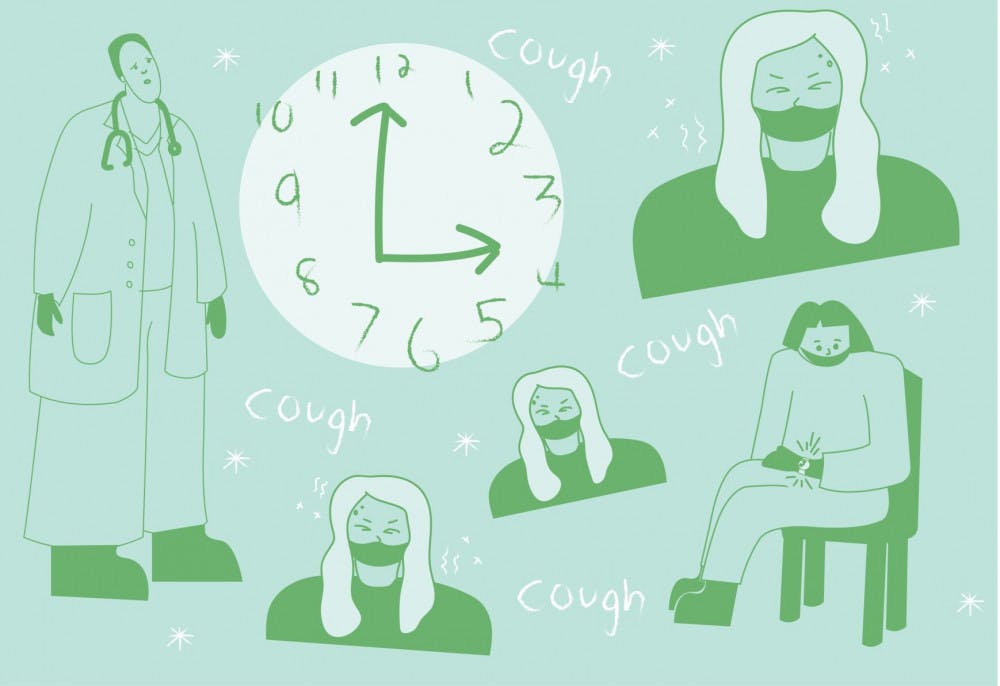
Emily Weingarten checked into UF Health Shands Emergency waiting room Saturday at about 6 p.m. with nausea, fatigue, a high fever and fear of appendicitis.
She didn’t leave until 4 a.m., and she never saw a doctor.
The 21-year-old said in the 10 hours she waited to be seen, she never saw anyone clean anything in the waiting room, despite the night-long revolving door of patients entering and leaving.
However, the UF business management senior said she did see people overcrowding, coughing near one another and tossing social distancing signs on the ground.
Out of Alachua County’s 136,133 COVID-19 tests, 5,117 people have tested positive according to the county’s dashboard. There were 35 new cases on Aug. 27.
In total, the county has seen 33 deaths, according to the Florida Department of Health’s dashboard.
Meanwhile, according to UF Health’s dashboard, there have been 28 positive tests among faculty and 48 positive tests among students through the university’s Return-to-Campus-Initiative with positivity rates of 0.23% and 0.45%, respectively. According to the dashboard, these tests only included people without symptoms.
There have been 195 students who have tested positive at the Student Health Care Center, resulting in a positivity rate of 18.6%.These tests included people with and without symptoms.
In July, students and faculty raised concern over an abnormally high positivity rate on UF Health’s dashboard, which implied 25% of UF’s 56,000 students tested positive. However, this number actually reflected the smaller population of symptomatic and asymptomatic students tested at the Student Health Care Center. The dashboard has since been updated to reflect this.
“Of all places, I thought an emergency room would be a safer place right now for some reason,” Weingarten said. “I thought they'd be extra careful — but it just did not feel like that.”
Ken Garcia, UF Health spokesperson, released a statement regarding the complaints saying the hospital will work to address the concerns.
“When we become aware of a concern, we work promptly to address it,” Garcia said.“High-quality care and a positive patient experience are our highest priorities.”
Some of UF Health’s safety protocols include limiting adult patients to one visitor, screening visitors for symptoms and requiring the use of face masks. Food and flower deliveries have also been eliminated, and the environmental services staff is responsible for “constant thorough cleaning” throughout the hospitals and emergency rooms.
But Weingarten said she didn’t see anyone clean anything in the near half day she was there. She also didn’t see any hand-sanitizing stations.
The Alligator confirmed that multiple parents complained to UF Health about the waiting room’s state Saturday, including Weingarten’s mother, Abby Weingarten.
Her daughter tested negative, but she said she was ultimately more concerned that her child would get sick from the waiting room itself.
“I was nervous as it is for her to go up to UF,” Abby Weingarten said. “When she first started not to feel well, we were like ‘oh my god, she got it already.’ I was a wreck.”
When Emily Weingarten arrived that evening, the staff first tested her blood. Then, they tested her for COVID-19.
She was sent back out into the crowded waiting room to wait for the results. But she was uncomfortable with the idea of herself — or any other patient — being told to wait around others while any of them might have COVID-19.
“After I was tested, I went and sat back out normally, which I thought was weird,” she said. “I didn't think I had [COVID-19], but if I did, then I just kind of sat back out there with everyone.”
Weingarten was accompanied by her friend, Mia Marks, a 21-year-old UF journalism senior. Both said they were surprised by the lax screening and disregard for social distancing in the waiting room.
Marks entered separately after dropping Weingarten off at the entrance. They both said they had their temperatures checked with a forehead thermometer upon entry, but beyond that, said the screening was minimal.
Despite UF Health’s protocol requiring visitors be stopped and screened for symptoms, Marks said she was given a visitor’s sticker and directed to the ER after only having her temperature taken.
At about 8:30 p.m., Marks left to get dinner. About an hour later, she returned to the waiting room but was surprised when none of the hospital workers acknowledged her entering.
“No one asked me who I was, no one stopped to see if I was a visitor or a patient or anything,” she said. “I could just walk right on in and right on out, and that part kind of scared us a little bit.”
A worker placed a coughing woman sitting in a wheelchair across from another patient because space was so limited, Weingarten said. This led to that patient complaining about being coughed on.
The woman sitting in the wheelchair had a mask on — as did most of the people in the waiting room, both Marks and Weingarten said — but the other patient still felt uncomfortable being seated in front of her.
Some seats in the waiting room had laminated pieces of paper on them marking spaces reserved for social distancing. The open spots appeared to be two seats apart, but Marks was unsure, because many patients disregarded signs loosely placed on the seats.
“People the entire night were picking them up, throwing them on the floor and putting them on the chair next to them and sitting wherever they wanted,” she said. “So it was kind of like there was no point in it.”
Marks left the waiting room Sunday around 3 a.m., and Weingarten soon followed after.
UF students continue to receive email after email detailing how they ought to remain confident in returning this Fall because of the extensive safety protocols and measures in place, Marks said.
“But if this is the first indication of how things are going to go, it does not make me feel hopeful about the semester,” Marks said.





